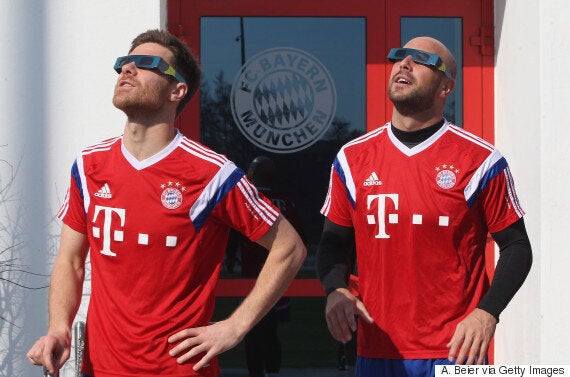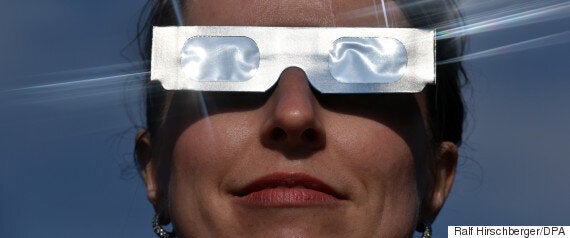Parts of the UK were plunged into darkness by a near-total solar eclipse on 20 March 2015, the first of its kind since 1999.
But when is the next one? We will be able to see some partial eclipses over the next decade, with the biggest coming in 2026. Our next chance to see a total eclipse, however, won't be until the end of the century.

Members of Bayern Munich watch the 2015 eclipse in Germany
- An eclipse passing over the USA in 2021 will allow us here in the UK to see a 30-50% eclipse, meaning we'll clock the moon covering a third to half of the Sun. It will occur on 10 June 2021.
- The following year, we'll likely see a 20-35% cover on 25 October, but it won't be until 2022 that we get another chance to see something as spectacular as a 90% eclipse.
- The partial solar eclipse on 12 August 2026 will allow Brits to see 80-95% of the Sun covered, with people in Iceland and Spain seeing a total eclipse.
- The next total eclipse in the UK, however, won't be until 23 September 2090, when many of us could be long gone. So keep the 12 August 2026 free.
We'll be counting down the days, hours, and minutes.
If you're going to attempt to watch the Solar Eclipse and not -- as tradition would perhaps dictate -- run and hide in mortal fear of the end times, you're going to have to think about safety.
No, you can't just stare at it. And looking up quickly and then looking away will still probably result in serious injury.
What you'll actually need is a pair of Solar Eclipse Glasses. The problem? They're virtually impossible to find. Luckily, there are alternatives.

According to the Royal Astronomical Society and Society for Popular Astronomy, even sunglasses or photographic negatives are not enough to avoid injury.
Instead it offered these following methods for viewing the phenomenon.
Eclipse viewing glasses: These are the only way of viewing the eclipse directly, other than through a telescope fitted with a professional filter. Similar to 3D glasses, eclipse viewers are made from card and inlaid with a special material that cuts the Sun's light down 100,000 times. If using a viewer, check for holes or scratches as it is only safe if undamaged.
Eclipse viewers are being given away free with the Society for Popular Astronomy's members' magazine and the BBC's Sky at Night magazine. Here are some places with glasses still in stock. Ebay is another - though you may end up paying silly prices for them.
Colander method: Take an ordinary kitchen colander and stand with your back to the Sun holding it in one hand and a piece of paper in the other. The holes in the colander can be used to project multiple eclipse images onto the paper.
Projection from binoculars or a telescope: Cover one eyepiece of a pair of binoculars with a lens cap and face the "big" end of the binoculars towards the Sun. The uncovered lens will project an image of the Sun that can be cast onto a plain card held about a foot away. Use the focus wheel to sharpen the image. Ideally, the binoculars should be fastened to a tripod or stand. A cardboard "collar" with holes cut to fit the large lenses will shade the card on which the image is projected.
The pinhole viewer: Pinholes allow light through them and can create an image like a lens. Make a small hole in a piece of card using a compass or other sharp-pointed implement. Standing with your back to the Sun, position another white card behind the one with the pinhole so that the Sun projects an image onto it. An alternative method uses a cereal box or something similar. Make a pinhole in one edge, point it towards the Sun, and a tiny image will be seen projected onto the inside of the box. A piece of white paper or card placed inside will make it easier to see.
Using a mirror: Cover a small flat mirror with paper that has a small hole cut in it. The hole does not have to be circular but should be no wider than 5mm. A larger hole will produce a brighter but fuzzier image.Prop up or clamp the mirror so that it reflects the sunlight onto a pale screen or wall, ideally through a window. A projection distance of five metres (16.4 feet) will produce an image of the Sun just over 5cm across. The eclipse can be seen in the image as the Moon starts to take a "bite" out of the Sun, appearing upside down compared with its position in the sky. The smaller the mirror and further away the wall, the sharper the image will be. Experiment with the distances and mirror size. Do not look into the mirror during the eclipse as this is just as dangerous as looking directly at the Sun.
READ MORE:
- Solar Eclipse 2015 Pictures, Livestream And Twitter Reaction
- Solar Eclipse Pictures: Best Images From Around The UK
- Could Bad Weather Cloud Our View Of The Sun?
- Solar Eclipse Glasses Won't Save You From The 'Day Of Judgement', Warn Pastors
- Fake Solar Eclipse 2015 Pictures: Don't Be Fooled
- International Space Station Solar Eclipse Picture ISN'T Real, That Hasn't Stopped Twitter
- 13 People Who Thought The Solar Eclipse Was Utterly Rubbish